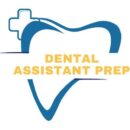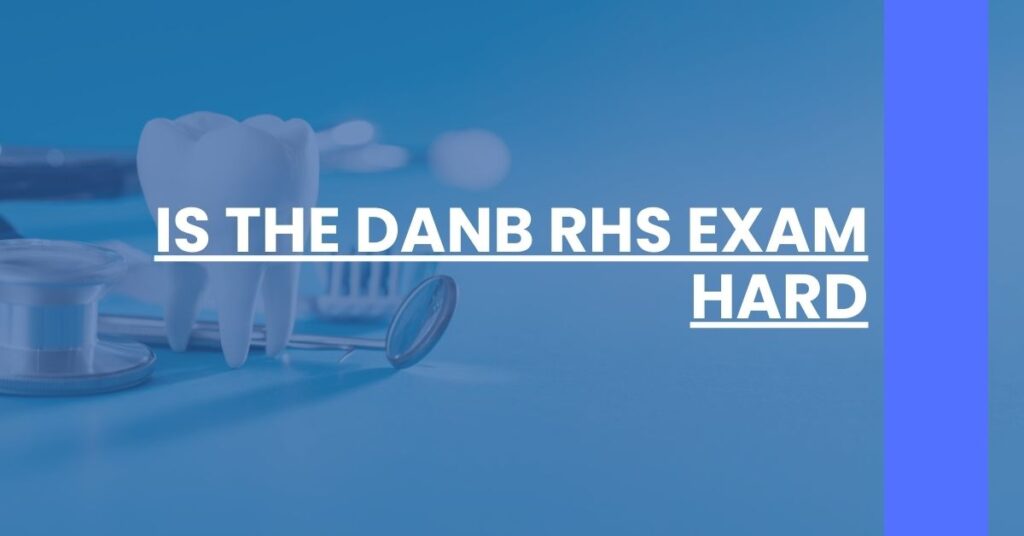Is the DANB RHS exam hard? It’s the big question on every dental assistant’s mind as they prepare for this pivotal test.
- Exam Complexity: Understand the depth and breadth of content that contributes to the difficulty level.
- Preparation Strategies: Learn effective study techniques and resources to conquer the exam’s challenges.
- Passing Projections: Gauge the success rates to assess what’s needed for a competitive edge.
Master these areas, and is the DANB RHS exam hard becomes just another query.
Overview of the DANB RHS Exam
The Dental Assisting National Board Radiography Health and Safety (RHS) examination is a critical stepping stone for dental assistants aiming to advance their career in the dental field. The examination assesses a candidate’s knowledge and understanding of various aspects of dental radiography, which is an integral part of dental practice.
What is the Purpose of the DANB RHS Exam?
The RHS exam validates a dental assistant’s proficiency in radiographic procedures and safety measures to protect both the patient and the practitioner. This includes ensuring a thorough understanding of radiation exposure, the technique required for clear and accurate imaging, and compliance with health and safety regulations. Successful completion of the RHS exam is often a requirement for obtaining certification or licensure in numerous states.
The Significance of Certification
A certification in radiography health and safety, such as the one offered through the DANB RHS exam, is not only a testament to a dental assistant’s ability but also a mandatory credential in some jurisdictions. It is a mark of professionalism and commitment to best practices in the field. States that require this certification do so to uphold a standard of care that protects public health and maintains compliance with respective state dental boards.
Assessing the Difficulty of the DANB RHS Exam
Determining how tough the DANB RHS exam can be subjective, varying from one individual to the next. However, specific factors contribute to the overall perception of the exam’s difficulty.
Exam Pass Rates
Pass rates can be an indicator of an exam’s difficulty. However, without publicly available statistics from DANB each year, it’s challenging to generalize the exam’s difficulty based on pass rates alone. That said, a strong understanding of the concepts covered and diligent study often results in successful outcomes.
Candidate Experiences
Candidates’ experiences with the RHS exam can vary widely. Those who find the exam challenging often cite the breadth of knowledge required and the stress of testing conditions. However, with ample preparation and the right study resources, many candidates find that they can navigate the exam confidently.
Complexity of Topics
The exam covers a broad range of topics related to radiation health and safety. The depth of understanding required for each subject can add to the difficulty, particularly if a candidate has not had extensive practical experience.
Exam Structure and Format
Understanding the structure and format of the DANB RHS exam is crucial for any candidate aiming to prepare effectively.
Number of Questions and Types
The RHS exam consists of 80 multiple-choice questions to be completed within a time span of an hour. This format requires quick thinking and a solid grasp of the subject matter to ensure timely completion.
Computer-Adaptive Testing
Furthermore, the exam employs a computer-adaptive testing method. Question difficulty adapts in response to the candidate’s performance as the test progresses. This functionality can enhance the challenge for test-takers, demanding a well-rounded knowledge of all covered areas.
Key Topics Covered in the Exam
To conquer the DANB RHS exam, candidates must be familiar with a wide range of topics, which are integral to the dental radiography field.
Fundamental Principles
- Radiation Physics: Understanding the basic principles behind x-ray production.
- Radiobiology: Comprehending how radiation affects biological tissues.
Imaging Techniques and Procedures
- Exposure Factors: Mastery of the settings that affect radiograph quality.
- Radiographic Imaging: Knowledge of the various types of radiographic images and techniques.
Radiographic Interpretation and Anatomical Landmarks
- Identifying Normal Anatomy: Being able to recognize typical anatomical landmarks visible in dental radiographs.
- Recognizing Abnormalities: Developing the skill to spot pathologies or other issues in radiographic images.
Radiological Safety
- Radiation Protection: Ensuring proper safety measures for patients and dental team members.
- Infection Control: Adhering to the protocols necessary to prevent cross-contamination in the radiology suite.
Legal Issues and Quality Assurance
- Compliance with Laws and Regulations: Awareness of legal responsibilities and guidelines governing dental radiography.
- Quality Control Procedures: Implementing regular checks and maintenance procedures to uphold radiographic quality standards.
Preparation Tips for the RHS Exam
Preparation can have a significant impact on the difficulty level of the RHS exam. Utilizing the best resources and study methods can make the difference between struggling with the material and having a strong showing on exam day.
Study Guides and Practice Tests
A variety of study guides and practice tests can provide structured preparation and simulate the experience of the actual exam. These materials not only convey the content but help familiarize candidates with the format and types of questions they will encounter.
Courses and Workshops
Candidates may find it beneficial to enroll in courses or workshops to enhance their understanding of dental radiography. These structured learning environments offer comprehensive coverage of the topics and can include hands-on practice, which is invaluable.
The Role of the DALE Foundation
The DALE Foundation, the official DANB affiliate, provides a variety of study aids designed to help prepare for the DANB RHS exam. These resources include review courses, practice tests, and textbooks, curated to align with the exam content outline.
Online Resources and Video Tutorials
Using online resources such as video tutorials can be an effective way to grasp complex concepts. Websites like Mometrix Academy offer free video tutorials as a part of their study resources for the RHS exam, which candidates can use to supplement their preparation efforts.
Common Challenges and How to Overcome Them
The DANB RHS exam presents a unique set of challenges that can make it particularly daunting for some candidates. Here are some typical hurdles and strategies for overcoming them:
Understanding Complex Concepts
- Key Concepts that Pose Difficulty: Some find the topics of radiation physics and radiobiology challenging due to their technical nature.
- Strategy: Utilize multiple study resources to gain varied perspectives on complex topics. Pair study guides with video tutorials for a multi-modal approach to learning.
Managing Test Anxiety
- The Pressures of Performance: The stakes are high, and performance anxiety can affect even the most prepared candidates.
- Strategy: Practice stress-reduction techniques such as mindfulness and deep breathing exercises. Regularly take full-length practice exams to become comfortable with the test-taking environment.
Time Management During the Exam
- The One-Hour Countdown: Completing 80 questions within 60 minutes can be strenuous, particularly if complex questions slow down the pace.
- Strategy: Work on timed practice tests to build speed and efficiency. Learn to recognize when to move on from a question to manage time effectively.
Computer-Adaptive Test Format
- Adapting to the Difficulty Curve: As the exam adapts to your performance, questions can become increasingly challenging.
- Strategy: Ensure a strong foundation in all topics since the difficulty level can shift at any time. Use practice tests that mimic the adaptive format to get accustomed to this dynamic.
By addressing these common challenges proactively, candidates can navigate the exam with increased confidence.
Test-Taking Strategies
To successfully tackle the DANB RHS exam, it’s not only about what you know but also how you apply that knowledge under exam conditions.
Familiarize Yourself with the Format
- The Layout of the Land: Understanding the structure of the test can greatly reduce anxiety.
- Strategy: Take practice exams that reflect the format of the actual test to become comfortable with the question styles and the computer-adaptive nature.
Process of Elimination
- Narrowing Down Choices: Multiple-choice questions give the opportunity to rule out incorrect answers.
- Strategy: Enhance critical thinking skills and develop a keen eye for details to effectively eliminate implausible answers.
Time Management Tips
- Budgeting Your Minutes: Efficiently distributing your time across questions is critical.
- Strategy: Aim to spend no more than 45 seconds per question, leaving extra time for review.
Reading Questions Carefully
- Avoiding Traps: Careful reading prevents misinterpretation, a common mistake under time pressure.
- Strategy: Practice active reading strategies and be particularly cautious with absolutes like “always” or “never.”
Attentive adoption of these strategies can greatly enhance exam performance.
Importance of Practical Experience
Real-world experience in dental radiography can be pivotal in enhancing your comprehension for the RHS exam.
Hands-On Skills Translate to Exam Success
- Bridging Theory and Practice: Actual experience with radiographic equipment and procedures can solidify theoretical knowledge.
- Strategy: Seek opportunities for live practice in a dental office or a simulation lab to reinforce learned concepts.
Learning Through Observation
- The Power of Visual Memory: Seeing procedures performed correctly can help in retaining information.
- Strategy: Intern or volunteer in a dental setting where radiography is performed regularly.
These experiences are invaluable for translating book knowledge into practical understanding, which is crucial for tackling the RHS exam effectively.
Support and Resources Available
Building a support network and utilizing available resources is essential for comprehensive exam preparation.
Study Groups and Peer Support
- The Collective Mind: Sharing experiences and knowledge through study groups can provide new insights into difficult areas.
- Strategy: Join online forums or local study groups to engage in discussions and shared learning sessions.
Institutional Assistance
- The Academic Helping Hand: Many dental programs offer tutoring services or additional resources for their students.
- Strategy: Reach out to your academic institution for guidance and support that might be available.
Accessing these support systems ensures a well-rounded approach to tackling the exam.
Enhancing Your Study Process
A robust study process is the foundation of a successful attempt at the DANB RHS exam.
Structured Study Plan
- Creating a Blueprint for Success: A predictable study timetable paves the way for steady progress.
- Strategy: Outline a study schedule, marking out time each day for different topics and including regular reviews.
Active Recall with Flashcards
- Memorization Optimized: Active recall is a proven technique to enhance memory retention.
- Strategy: Employ flashcards both digital and physical to solidify your knowledge of key terms and concepts.
Solo vs Group Study: Knowing What Works for You
- The Individualistic vs The Collective Approach: Some thrive on solo review while others benefit from group discussion dynamics.
- Strategy: Experiment with both solo and group study to determine which is most conducive to your learning style.
Optimizing your study habits greatly increases the likelihood of exam success while potentially making the material less daunting.

